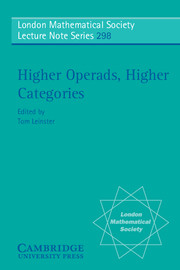Introduction
Published online by Cambridge University Press: 08 January 2010
Summary
It must be admitted that the use of geometric intuition has no logical necessity in mathematics, and is often left out of the formal presentation of results. If one had to construct a mathematical brain, one would probably use resources more efficiently than creating a visual system. But the system is there already, it is used to great advantage by human mathematicians, and it gives a special flavor to human mathematics.
Ruelle (1999)Higher-dimensional category theory is the study of a zoo of exotic structures: operads, n-categories, multicategories, monoidal categories, braided monoidal categories, and more. It is intertwined with the study of structures such as homotopy algebras (A∞ -categories, L∞-algebras, Γ-spaces, …), n-stacks, and n-vector spaces, and draws it inspiration from areas as diverse as topology, quantum algebra, mathematical physics, logic, and theoretical computer science.
No surprise, then, that the subject has developed chaotically. The rush towards formalizing certain commonly-imagined concepts has resulted in an extraordinary mass of ideas, employing diverse techniques from most of the subject areas mentioned. What is needed is a transparent, natural, and practical language in which to express these ideas. The main aim of this book is to present one. It is the language of generalized operads. It is introduced carefully, then used to give simple descriptions of a variety of higher categorical structures.
I hope that by the end, the reader will be convinced that generalized operads provide as appropriate a language for higher-dimensional category theory as vector spaces do for linear algebra, or sheaves for algebraic geometry.
- Type
- Chapter
- Information
- Higher Operads, Higher Categories , pp. 1 - 6Publisher: Cambridge University PressPrint publication year: 2004



